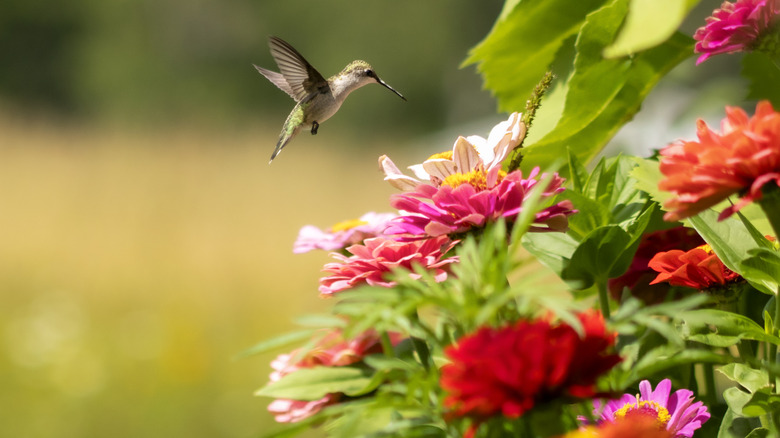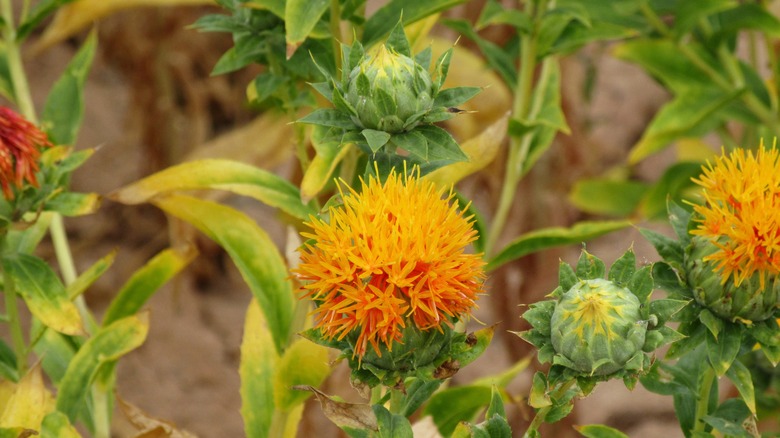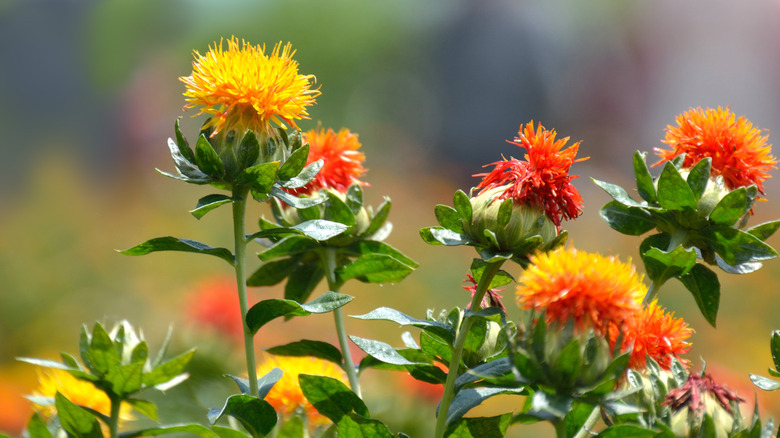Add This Easy-To-Grow Plant To Your Garden & You Won't Have To Buy Birdseed Again
Do you constantly find yourself restocking your bird feeder? In a way, that's a small price to pay for inviting wild birds to your yard. But if you'd rather save the money, you'll be happy to know that there's a more natural way to get appetizing birdseed on your property. Safflower seeds are a favorite among several bird species, and safflowers are not difficult to grow if you're in USDA zones 3 through 9 (that's most of the contiguous U.S. and Alaska). You can plant these annuals every year in your garden, and the seeds will be ready for harvest come early fall.
Birds like safflower seeds for a good reason — they're packed with nutrients that help the birds stay energetic. Species that like to feast on safflower seeds include the Cardinal, White-breasted Nuthatch, Indigo Bunting, and Steller's Jay. On the other hand, squirrels are repulsed by these seeds, so supplementing your bird food supply with safflower seeds is a good way to stop squirrels from hogging the bird feeder. Below, we'll explain how to seed and grow this heirloom plant properly so you never have to buy birdseed again!
Planting safflower in your yard
Before planting safflower, find a fitting location for the plants in your yard. Safflower likes full sun to partial shade, but you must also consider its soil preferences. These plants thrive in soil that's loamy, deep, rich in nutrients, and can hold good amounts of water. Soils with lower water-holding capacity can work, too, as long as your region gets plentiful rain or you water the plants regularly. Another point to consider is that this plant is an annual, but it's best to rotate its location every year. So, if you've grown safflower in a particular spot one year, don't plant them in the same location the following year; use another part of your yard instead.
The best time to plant safflower is in the spring, particularly after the soil temperature stays at or above 40 degrees Fahrenheit to encourage germination. Planting later in the season leaves the plants vulnerable to early fall frosts and reduces the number of seeds the plants can produce. When you're ready to plant, check out your local nursery or search online to see where safflower seeds can be found. Then, you have two options for planting the seeds. You can moisten the soil in advance and plant the seeds at a depth of 1.5 inches (no deeper than 2 inches). Alternatively, if you know rains are coming, you can seed into dry soil and wait for the rains to give seeds the moisture necessary for germination.
How to take care of safflower plants
Once the safflowers germinate, keep the soil moist until the plants mature. That said, avoid overwatering the plant, as waterlogging could cut off the oxygen supply to its roots and kill it. After the safflowers have established, they're able to tolerate droughts well. You can determine the fertilization needs by testing the soil. Although safflowers' long roots grow as deep down as 4 feet, where nitrogen should be abundant, this may not be the case in your location. What's more, the soil may lack sufficient phosphorus or potassium, and only a soil test performed deep enough (at least 2 feet deep) can tell you which elements should be supplemented with fertilization.
Crucially, do your best to get rid of weeds in your garden. Unfortunately, safflower seedlings cannot outcompete weeds for resources; without your help, they won't survive. Some diseases can threaten your safflower patch, particularly during wet, humid times of the year. Several types of root rot, Verticillium wilt, and Pseudomonas bacterial blight are all possible, and you may have to opt for commercially available treatments to deal with these. The most serious illness that can affect your safflowers is the Alternaria leaf spot, which may be remedied with a foliar treatment. Fortunately, insects are not a major problem for safflowers, although it's wise to protect the plants from wireworms and grasshoppers. Find out how to protect your garden from bugs with eco-friendly methods.
It is important to note that the U.S. Department of Agriculture considers the wild safflower to be "Moderate Risk of becoming weedy or invasive in the United States." Please check your state and local list of invasive plants to determine whether or not this may be the best choice for your garden.


